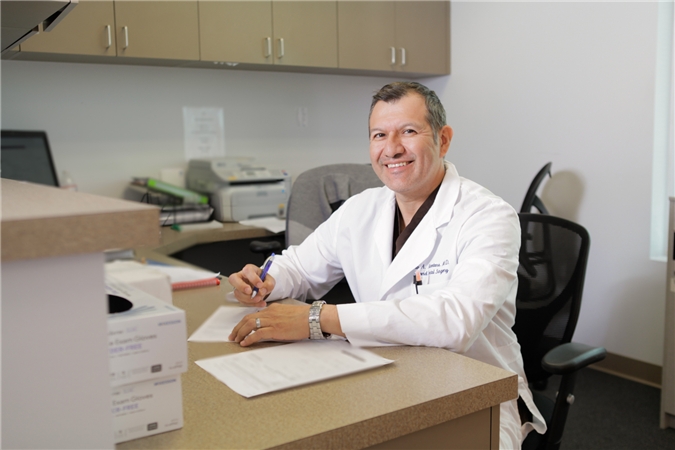
LEARN HOW SPC CAN ENHANCE YOUR PROCEDURE.
Sonterra Procedure Center’s (SPC) highly skilled team of colon and rectal surgeons is dedicated to providing the most advanced, personalized care. Our double boarded surgeons bring more than 60 years of combined expertise and our dedicated staff ensure quality outcomes. We utilize the latest advances in medicine combined with state-of-the-art techniques for endoscopy procedures, outpatient surgical procedures, and the treatment of incontinence. SPC is San Antonio’s first nationally recognized incontinence center and has been serving patients for more than decade.
Our surgeons are fluent in both English and Spanish. Additionally, most of our staff are also bilingual for those patients and their families who are primarily Spanish speaking.


Colonoscopy
A colonoscopy is a procedure a physician uses to look at the inside of the colon and rectum — such as swollen, irritated tissues, polyps or cancer — in the large intestine (colon) and rectum.
During a colonoscopy, a colonoscope is used, which is a long, flexible tube about the width of a finger. It is a inserted into the rectum and has a tiny video camera at the tip of the tube and a light which allows the doctor to view the inside of the entire colon. If necessary, special instruments can be passed through the colonoscope to biopsy or remove any suspicious-looking areas such as polyps.
Endoscopy
Endoscopy is a procedure where a physician uses a tube-like instrument to look inside the body. There are various types of endoscopy, each of which is designed for looking at a certain part of the body.
Upper GI Endoscopy
An Upper GI endoscopy is a procedure to diagnose and treat problems in the upper gastrointestinal (GI) tract. The upper GI tract includes the esophagus, stomach, and the first part of your small intestine. This procedure is done using a long, flexible tube called an endoscope. The tube has a tiny video camera at the tip of the tube and a light which allows the doctor to view inside. It is put into your mouth and throat, then slowly pushed through your esophagus and stomach, and into your duodenum. Video images from the tube are seen on a monitor.
This procedure is done using a long, flexible tube called an endoscope. The tube has a tiny light and video camera on one end. The tube is put into your mouth and throat. Then it is slowly pushed through your esophagus and stomach, and into your duodenum. Video images from the tube are seen on a monitor.
Small tools may also be inserted into the endoscope. These tools can be used to:
- Take tissue samples for a biopsy
- Remove things such as food that may be stuck in the upper GI tract
- Inject air or fluid
- Stop bleeding
- Conduct procedures such as endoscopic surgery, laser therapy, or dilate a narrow area
Hemorrhoidectomy
A hemorrhoidectomy is surgery to remove internal or external hemorrhoids that are extensive or severe. These are swollen veins in the annual area. During this surgery, the doctor will cut out the swollen veins. After surgery, the pain and itching caused by hemorrhoids should go away. Surgical hemorrhoidectomy is the most effective treatment for hemorrhoids.
Anorectal Fistulotomy
The most common type of surgery for anal fistulas is a fistulotomy. An anal fistulotomy is surgery to open and drain an anal fistula, helping the fistula to heal. This involves cutting along the whole length of the fistula to open it up, so it heals as a flat scar. It is the most effective treatment but usually only recommended for fistulas that do not pass through much of the sphincter muscles, since the risk of incontinence is lower in these cases.
Hernia Repair
Hernia repair surgery is the most common treatment for a hernia. With a hernia, an organ pushes through the muscle or tissue wall that holds it. Most hernias form in the abdomen or groin. Hernia surgery allows your surgeon to push the organ and herniated tissue back into place and reinforce the barrier holding it there using stitches or surgical mesh.
The three main types of hernia surgery are open, laparoscopic (minimally invasive), and robotic repair. Surgery and recovery depends on the type of hernia and how complex the surgery might be.
Incontinence Treatment
Urinary incontinence is the unintentional passing of urine. It’s a common problem that affects millions of people. There are several types of urinary incontinence, including:
- ·stress incontinence – when urine leaks out at times when your bladder is under pressure; for example, when coughing or laughing
- urge (urgency) incontinence – when urine leaks and there’s a sudden intense urge to pee, or soon afterwards
- overflow incontinence (chronic urinary retention) – unable to fully empty bladder, which can cause frequent leaking
- total incontinence – when the bladder cannot store any urine at all, causing urine to pass constantly or frequent leaking
- It is also possible to have a mixture of both stress and urge urinary incontinence
Sacral Nerve Stimulator
Sacral Neuromodulation (SNM), also known as Sacral Nerve Stimulation, is a therapy that can help people who experience bladder and bowel problems, and the treatment can be a life changing therapy.
SNM is not suitable for everyone and your physician or healthcare professional can discuss this option.
Sacral Neuromodulation Therapy can help to restore normal bladder or bowel function. The therapy addresses the communication problem between the bladder or bowel and the brain, and a diagnostic trial of therapy is used for a few weeks to see if it is successful.
SNM is also used for the treatment of an overactive bladder, urinary retention, urgency frequency, urge incontinence, and fecal incontinence.
Sacral neuromodulation (SNM) is performed because millions of people are affected by overactive bladder and are refractory to behavioral modifications or pharmacotherapy. Indications for SNM include urinary retention, urgency frequency, urge incontinence, and fecal incontinence. This activity describes sacral neuromodulation and reviews the interprofessional team’s role in evaluating and treating patients who undergo this procedure.
Wound Care
If you have severe or chronic wounds, or surgical incisions, you might benefit from experienced wound care. There are many types of chronic wounds, which don’t heal through normal treatment methods. The most common types of wounds include:
- Arterial ulcers
- Chronic wounds
- Diabetic foot ulcers
- Nonhealing surgical wounds
- Pressure ulcers
- Traumatic wounds
- Vasculitic ulcers (leg)
- Venous stasis ulcers (ulcers and skin damage due to malfunctioning veins)
Education is key for any type of wound care plan. At SPC, you will receive an individualized treatment care plan and also instructions and information to help the healing process.
Surgery
Anal cancer surgery is most successful when performed by a specialist with a great deal of experience in the particular procedure. If surgery is needed to treat anal cancer, one of the following procedures might be utilized:
Local resection: The tumor, along with some of the tissue around it, is surgically removed.
Abdominoperineal resection (APR): The anus, the rectum and part of the colon are removed through an incision in the abdomen. The end of the intestine is attached to an opening (stoma) in the abdomen. Body waste leaves this opening and is collected in a plastic bag outside the body. This also is called a colostomy.
The cancer staging system continues to evolve and is becoming more complex as doctors improve cancer diagnosis and treatment. Your doctor will evaluate and suggest treatment options for you.

